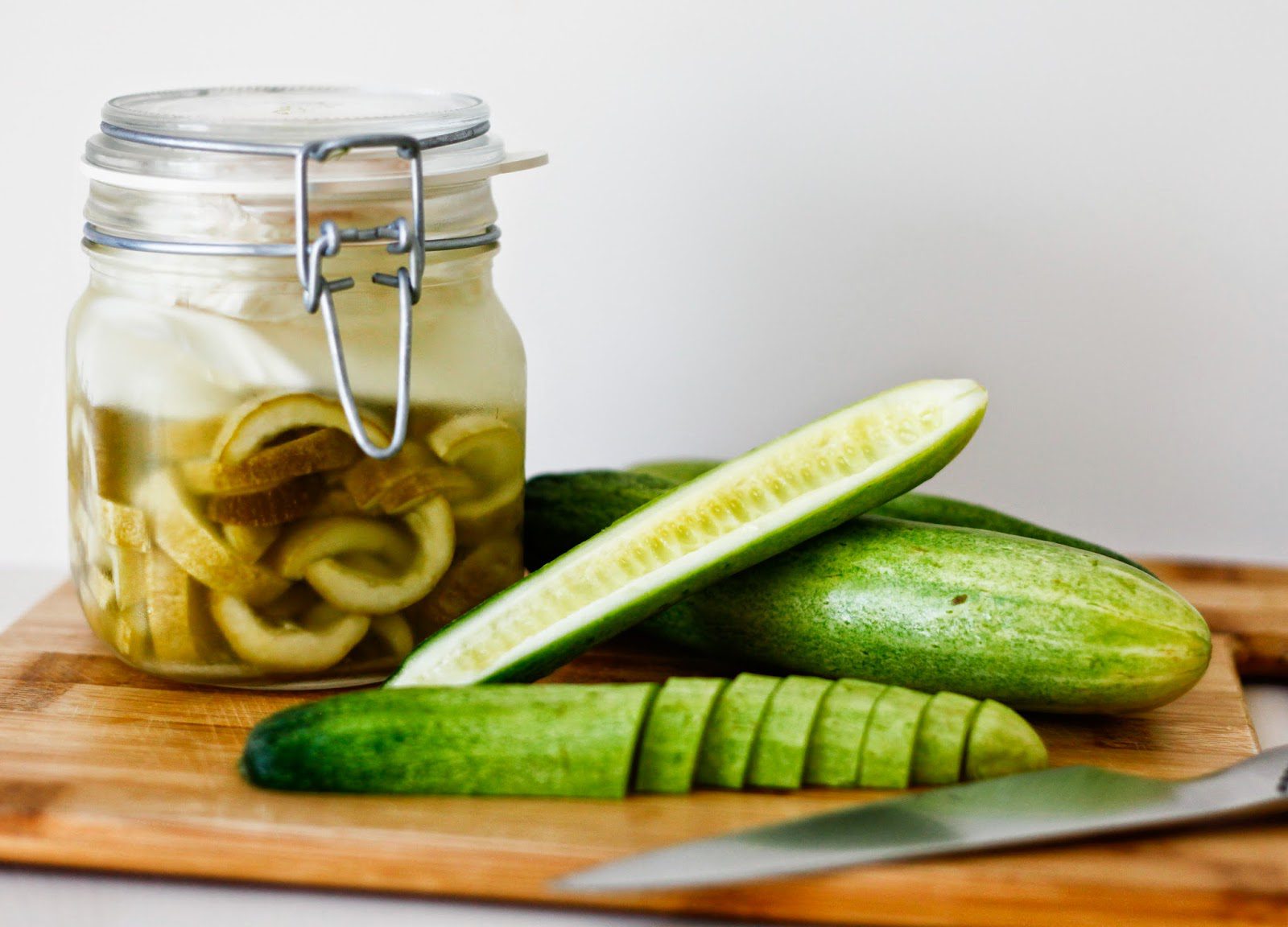
Lacto-fermented Cucumbers (Pickles)
 |
| Lacto-fermented Cucumbers (Pickles) |
I always use Body Ecology Veggie Culture Starter, for my family’s needs in healing my childs gut, I like to know I start off with all the right good bacteria. I also found out recently that the specific strain which is found in the Body Ecology Culture starter L. plantarum is the only Lactobacillus probiotic that can produce natural folate for the body (which it cannot manufacture on it’s own). How amazing is that?!
If you live in Australia, you can order your Body Ecology products from here. Enter discount code ‘loveurbelly’ for 5% off or order direct from Body Ecology USA.
- 1 litre (1 Quart size approx) Jar with Flip Top lid/lock (e.g. Fido Jar)
- 5 cucumbers
- 1 litre clean filtered water (boiled and cooled if unsure)
- 2-3 tbsp natural sea salt
- 1 sachet Body Ecology Veggie Culture Starter optional and 1/2 tsp organic sugar
- 2 cabbage outer leaves or cut 2 wedges of cabbage (all the cabbages seem to have the outer leaves removed over here so I have been using wedges of cabbage, they end up fermented too so I also eat them with the cucumbers)
Method Using Culture Starter:
- Take the sachet out of the fridge to allow it to come to room temperature
- Clean the jar and all utensils (knife, board) with hot water and vinegar and sit on a dish rack or clean tea towel to air dry
- Wash the cucumbers and sit on a clean tea towel to dry
- In a small glass, add some of the water and dissolve halve a tsp of organic sugar (if using the Culture starter, skip if not)
- Empty the sachet into the glass to allow the bacteria to wake up and start feeding on the sugar
- Halve the cucumbers and using a teaspoon, scrape out the seeds
- Slice the cucumbers to desired thickness and place in the jar
- Fill the jar up leaving 1 inch from the top, press the cucumbers down using your hands
- Make a brine by dissolving 1 tsp salt with the water, then add the culture starter mixture (salt is used to inhibit the growth of bad bacteria to give the good bacteria a good start to do their thing. Using a culture starter allows you to use less salt, if you prefer softer veggies you can reduce the salt further, increase the salt for more crunch)
- Pour the brine over the cucumbers until just covered
- Roll up each cabbage leaf (or place the cabbage wedges) and place on top of the cucumbers to keep them under the brine
- Keep the jar on the counter out of the sun or in a cupboard for 5-7 days, they should keep for well over 6 months
- Once opened, store them in the fridge
- Don’t forget to always use clean utensils – no fingers! this will keep your jar lasting a lot longer once it is opened.
- Clean the jar and all utensils (knife, board) with hot water and vinegar and sit on a dish rack or clean tea towel to air dry
- Wash the cucumbers and sit on a clean tea towel to dry
- Halve the cucumbers and using a teaspoon, scrape out the seeds
- Slice the cucumbers to desired thickness and place in the jar
- Fill the jar up leaving 1 inch from the top, press the cucumbers down using your hands
- Make a brine by dissolving approximately 2-3 tbsp salt with the water (not all salts are the same so you can adjust the salt to your taste but remember salt is used to inhibit the growth of bad bacteria to give the good bacteria naturally present in the veggies a good start to do their thing, if you prefer softer veggies you can reduce the salt. Too much salt can inhibit all the bacteria and the veggies won’t ferment so I do not recommend using anymore than 3 tbsp per litre of water or any less than 2 tbsp without a culture starter)
- Pour the brine over the cucumbers until just covered
- Roll up each cabbage leaf (or place the cabbage wedges) and place on top of the cucumbers to keep them under the brine
- Keep the jar on the counter out of the sun or in a cupboard for 5-7 days, they should keep for well over 6 months
- Once opened, store them in the fridge
- Don’t forget to always use clean utensils – no fingers! this will keep your jar lasting a lot longer once it is opened.
I really recommend the below books if you want to know more about fermentation, I found them really useful when I first started out:
Nourishing Traditions by Sally Fallon
The Art of Fermentation by Sandor Katz
Wild Fermentation by Sandor Katz
The Body Ecology Diet by Donna Gates
- 1 litre (1 Quart size approx) Jar with Flip Top lid/lock (e.g. Fido Jar)
- 5 cucumbers
- 1 litre clean filtered water (boiled and cooled if unsure)
- 2-3 tbsp natural sea salt
- 1 sachet Body Ecology Veggie Culture Starter optional and ½ tsp organic sugar
- 2 cabbage outer leaves or cut 2 wedges of cabbage (all the cabbages seem to have the outer leaves removed over here so I have been using wedges of cabbage, they end up fermented too so I also eat them with the cucumbers)
- Take the sachet out of the fridge to allow it to come to room temperature
- Clean the jar and all utensils (knife, board) with hot water and vinegar and sit on a dish rack or clean tea towel to air dry
- Wash the cucumbers and sit on a clean tea towel to dry
- In a small glass, add some of the water and dissolve halve a tsp of organic sugar (if using the Culture starter, skip if not)
- Empty the sachet into the glass to allow the bacteria to wake up and start feeding on the sugar
- Halve the cucumbers and using a teaspoon, scrape out the seeds
- Slice the cucumbers to desired thickness and place in the jar
- Fill the jar up leaving 1 inch from the top, press the cucumbers down using your hands
- Make a brine by dissolving 1 tsp salt with the water, then add the culture starter mixture (salt is used to inhibit the growth of bad bacteria to give the good bacteria a good start to do their thing. Using a culture starter allows you to use less salt, if you prefer softer veggies you can reduce the salt further, increase the salt for more crunch)
- Pour the brine over the cucumbers until just covered
- Roll up each cabbage leaf (or place the cabbage wedges) and place on top of the cucumbers to keep them under the brine
- Keep the jar on the counter out of the sun or in a cupboard for 5-7 days, they should keep for well over 6 months
- Once opened, store them in the fridge
- Don't forget to always use clean utensils - no fingers! this will keep your jar lasting a lot longer once it is opened.



